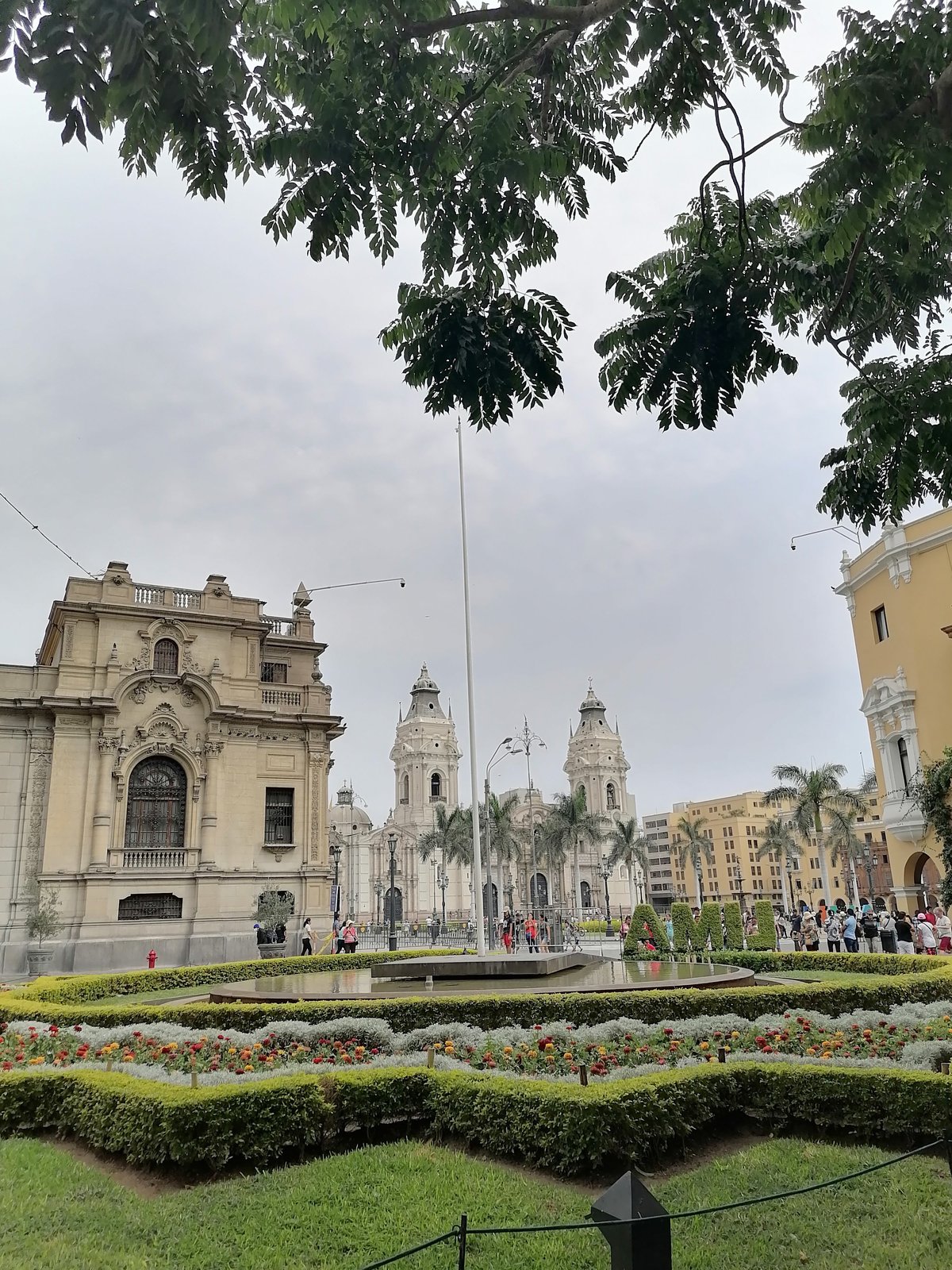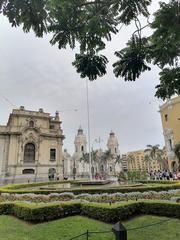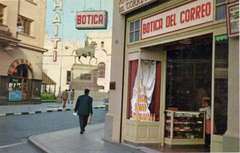
Plaza Perú Lima Visitor Guide: Visiting Hours, Tickets, and Nearby Attractions
Date: 14/06/2025
Introduction: Plaza Perú, Its History, and Significance
Plaza Perú is a quintessential emblem of Lima’s rich historical fabric, urban evolution, and vibrant cultural life. Rooted in Spanish colonial tradition, it reflects the urban planning model that shaped much of Latin America, serving as a nucleus for political authority, religious institutions, and social gathering. Associated with pivotal historical figures such as Francisco Pizarro and events like Peru’s independence, Plaza Perú today stands as a dynamic intersection of colonial heritage, republican transformation, and modern urban identity (Wikipedia; Free Walking Tours Peru; Machu Travel Peru).
Situated between Lima’s Government Palace and Municipal Palace, the plaza offers a compact yet potent space framed by baroque, neoclassical, and modern architectural styles. Its centerpiece—a circular pool with the national flag—serves as a stage for civic ceremonies, festivals, political gatherings, and daily leisure, making Plaza Perú both a historical landmark and a thriving public venue (Wikipedia; EAA).
For visitors, Plaza Perú offers free, year-round access, wheelchair-friendly paths, and proximity to key Lima attractions such as the Lima Cathedral, Archbishop’s Palace, and Casa de Aliaga. Whether you’re exploring its historic architecture, attending cultural events, or simply enjoying the lively atmosphere, this guide provides a comprehensive overview of Plaza Perú’s historical context, cultural importance, and practical visitor tips.
Contents
- Discover Plaza Perú: Lima’s Historic Heart
- Colonial Foundations and Urban Planning
- Evolution Through the Republican Era
- Architectural and Cultural Significance
- Social and Community Role
- Preservation and Contemporary Challenges
- Practical Visitor Tips: Visiting Hours, Tickets, and Accessibility
- Visual Experience and Media
- Nearby Attractions
- Frequently Asked Questions (FAQ)
- Plaza Perú in Lima: Visiting Hours, History, and Must-See Monuments
- Urban Layout and Historical Context
- Architectural Styles and Notable Structures
- Notable Monuments and Artworks
- Visitor Information
- Events and Cultural Activities
- Preservation and Significance
- Call to Action
- Plaza Perú in Lima: Historical and Political Significance
- Location and Accessibility
- Activities and Experiences
- Practical Tips for Visitors
- Local Etiquette and Safety
- Summary and Sources
Discover Plaza Perú: Lima’s Historic Heart
Plaza Perú stands as a captivating historical site, seamlessly blending colonial heritage with contemporary urban life. Its evolution encapsulates Lima’s journey from Spanish conquest to modern cosmopolitan capital.
Colonial Foundations and Urban Planning
Like other principal squares in Lima, Plaza Perú was conceived following the Spanish colonial mandate to create a central plaza as the nucleus of new American cities (Wikipedia). This grid pattern, established in the 16th century, organized civic, religious, and social life around the plaza. Such design was intended to assert Spanish authority and foster community cohesion, with important buildings—government offices, churches, and elite homes—framing the square (LAC Geographic).
Evolution Through the Republican Era
Following independence in 1821, Lima’s plazas—including Plaza Perú—underwent significant transformation. Republican ideals brought new architectural styles and public uses, with gardens, fountains, and monuments celebrating Peruvian heroes. Infrastructure improvements such as public lighting and tramways integrated the plaza into Lima’s expanding, modernizing cityscape (Wikipedia).
Architectural and Cultural Significance
Plaza Perú is framed by an eclectic mix of republican-era, modern, and residential buildings (LAC Geographic). Ornamental gardens, wrought-iron benches, and decorative lighting create an inviting environment. Central features like fountains or statues commemorate local history, reinforcing the plaza’s role as a site of collective memory.
Culturally, Plaza Perú serves as a stage for daily life, from children playing to organized festivals and political demonstrations. This versatility makes it a vital space for both ordinary and extraordinary events (Salkantay Trekking).
Social and Community Role
As the “heart of social life” in Lima, Plaza Perú is where people of all ages and backgrounds gather (Salkantay Trekking). The plaza hosts cultural events throughout the year, attracting both locals and visitors (Exploor Peru).
Preservation and Contemporary Challenges
Urbanization, environmental stress, and increased commercial activity present challenges to the plaza’s preservation (UNESCO). Restoration efforts focus on historical features, green spaces, and community stewardship to ensure the plaza’s vitality for future generations.
Practical Visitor Tips: Visiting Hours, Tickets, and Accessibility
- Visiting Hours: Plaza Perú is accessible year-round, usually from 6:00 AM to 10:00 PM. There is no entrance fee.
- Tickets & Entry: No tickets are required.
- Accessibility: Wheelchair-friendly with paved pathways and ramps. Public transportation, taxis, and ride-share options are available.
- Safety: Generally safe during visiting hours. Take standard precautions with personal belongings.
Visual Experience and Media
Enhance your visit by exploring high-quality images and virtual tours of Plaza Perú online. Many tourism websites and apps provide photo galleries showcasing its architecture and cultural events.
Nearby Attractions
Plaza Perú’s central location allows easy access to other historical sites, including the Lima Cathedral, Archbishop’s Palace, Casa de Aliaga, museums, churches, and bustling markets (Exploor Peru).
Frequently Asked Questions (FAQ)
Q: What are the plaza’s visiting hours?
A: Open daily from approximately 6:00 AM to 10:00 PM.
Q: Is there an entrance fee?
A: No, it is free to enter.
Q: Is it accessible for people with disabilities?
A: Yes, paved pathways and ramps make it wheelchair accessible.
Q: Are there cultural events at Plaza Perú?
A: Yes, check local listings for events, performances, and exhibitions.
Q: How do I get there?
A: The plaza is well-served by local buses, taxis, and ride-shares.
Plaza Perú in Lima: Visiting Hours, History, and Must-See Monuments
Urban Layout and Historical Context
Plaza Perú, once known as Francisco Pizarro Square, is located in central Lima beside the Plaza Mayor. Its current form dates to 1952, marking Lima’s adaptation of its colonial grid (Wikipedia). The surrounding “Pizarro’s Grid” is a remarkably intact example of Spanish colonial urbanism (Free Walking Tours Peru; UNESCO via Free Walking Tours Peru).
Architectural Styles and Notable Structures
- Government Palace: Official residence of the President, built in 1938 with French Baroque influences, standing on Francisco Pizarro’s original home (EAA).
- Municipal Palace: Neocolonial style, housing Lima’s municipal government (Free Walking Tours Peru).
- Surrounding Architecture: A blend of colonial, baroque, and neoclassical styles, with 17th-century balconies and arcades (The Collector).
Notable Monuments and Artworks
- Central Pool and National Flag: Installed in 2003, the pool replaced the Pizarro statue and is now a focal point for ceremonies (Wikipedia).
- Equestrian Statue of Francisco Pizarro: Once at the plaza but relocated in 2003 due to controversy (Wikipedia).
- Lima Cathedral: A nearby masterpiece blending Renaissance, Baroque, and Neoclassical styles (The Collector).
- Archbishop’s Palace and Casa de Aliaga: Further examples of Lima’s colonial architecture (Wanderlog; EAA).
Visitor Information
- Hours: Open 24/7, though daylight visits are recommended.
- Tickets: Free entry. Guided tours available—book online or locally (Destinationless Travel).
- Accessibility: Generally accessible for those with mobility impairments.
- Events: Hosts official ceremonies, protests, and cultural activities (DestGuides).
Plaza Perú: Historical and Political Significance
Established in 1535, Plaza Perú was Lima’s founding point and has witnessed defining moments such as Peru’s independence (Free Walking Tours Peru; Machu Travel Peru). The design, centered on the plaza with key government and church buildings, reflects colonial ideals of order and power.
Political Role
The plaza has been a stage for political events, protests, and celebrations, including annual Independence Day activities (BBC News). Its accessibility and symbolism make it central to Peru’s public life.
Cultural Significance
Surrounded by architectural landmarks like the Government Palace and Lima Cathedral, Plaza Perú is a living museum of colonial, republican, and modern influences (Machu Travel Peru). The square bustles with social life, festivals, and serves as a hub for guided tours (Free Walking Tours Peru).
Symbol of Diversity
Plaza Perú brings together people from diverse backgrounds, reflecting Peru’s ethnic and social complexity. The plaza’s role as a site of protest and reconciliation highlights its importance in the nation’s dialogue about inclusion and democracy (GJIA; BBC News).
Location and Accessibility
Plaza Perú is also found in Lima’s San Isidro district, an elegant, tranquil neighborhood accessible by Metropolitano bus, taxi, or on foot from Miraflores or the historic center (My Adventures Across the World). The area is known for its safety, green spaces, and upscale ambiance.
- Hours/Tickets: Open 24 hours, no admission fee.
- Accessibility: Wheelchair-accessible paths, curb cuts, and nearby public transport.
- Safety: Regular police patrols; standard urban precautions advised (Solo Guides).
Activities and Experiences
- People-Watching & Relaxation: Benches and shaded areas invite visitors to linger and enjoy the plaza’s ambiance.
- Dining: From casual cafes to acclaimed restaurants like Astrid y Gastón (PlanetWare), the area caters to a range of tastes and budgets.
- Guided Tours: Walking tours often include Plaza Perú and nearby attractions such as Huaca Huallamarca (Lonely Planet).
- Photography: Early morning and late afternoon provide the best light for capturing the plaza’s architecture and greenery.
Practical Tips for Visitors
- What to Bring: Comfortable shoes, sun protection, water bottle, and a camera.
- Language: Spanish is the primary language; basic phrases enhance your visit.
- Wi-Fi: Available in cafes and restaurants—consider a local SIM card for full connectivity.
- Budget: Enjoy the plaza for free; picnics and local cafes offer affordable dining.
Local Etiquette and Safety
Dress smart-casual, greet with “buenos días” or “buenas tardes,” and tip 10% at restaurants. In emergencies, contact the Tourist Police by dialing 105 (My Adventures Across the World).
Summary: Key Points and Final Thoughts
Plaza Perú encapsulates Lima’s historical depth, architectural grandeur, and socio-political vitality. From its colonial origins to its contemporary role as a civic and cultural hub, the plaza offers visitors a profound encounter with Lima’s layered identity (Wikipedia; Machu Travel Peru). Its open, accessible layout and proximity to major landmarks make it essential for any Lima itinerary. Guided tours, optimal visiting hours, and nearby culinary and cultural offerings further enhance the experience (EAA; BBC News).
For the latest updates, virtual tours, and detailed guides, download the Audiala app and consult the resources below (Free Walking Tours Peru; My Adventures Across the World).
Sources
- Plaza Mayor, Lima, Wikipedia, 2024
- Historic Center Lima Peru, LAC Geographic, 2024
- Lima Everything You Need to Know About the Capital of Peru, Salkantay Trekking, 2024
- Historic Center of Lima Peru, Free Walking Tours Peru, 2024
- 10 Best Architectural Buildings in Lima Peru, EAA, 2024
- Famous Landmarks Peru, DestGuides, 2024
- Main Square of Lima Peru, Machu Travel Peru, 2024
- Top Historical Sites Lima Peru, The Collector, 2024
- Most Historic Buildings and Sites in Lima, Wanderlog, 2024
- Things to Do in Lima Historic Center, Exploor Peru, 2024
- Peru’s Recent Protests: Causes, Responses, Georgetown Journal of International Affairs, 2023
- BBC News Latin America, 2023
- Visiting Lima Travel Tips, My Adventures Across the World, 2024
- Top Things To Do In Lima, Lonely Planet, 2024
- Lima Travel Guides, Peru For Less, 2024
- Lima Attractions, PlanetWare, 2024
- Solo Guides Lima
















































































































